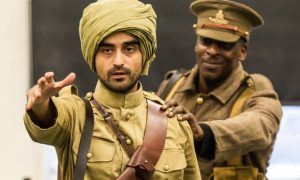Kamila Shamsie in The Guardian:
 History does not record whether there was any contact during the first world war between the men of the Indian army who were being treated in hospitals in Brighton for injuries sustained on the western front and the men of the British West Indies regiment training further along the Sussex coast in Seaford. If there was, they’d have had much to discuss, both in terms of the camaraderie between soldiers and the racial discrimination that followed these men who had volunteered to fight for the empire. Khudadad Khan of the Indian army, the first Indian to receive a Victoria Cross, might have had something to say about the scandal that erupted in 1915 when the Daily Mail ran a picture of him in hospital with a white nurse standing beside his bed. The following month, the army council issued a directive calling for the removal of all white nurses from three military hospitals where Indian soldiers were being treated. Perhaps the soldiers of the British West Indies regiment would have thought this a petty grievance compared with their own. Having signed up, they discovered they were not allowed to fight because black men could not be trusted with guns. Instead, they were relegated to labour battalions, often on the front lines.
History does not record whether there was any contact during the first world war between the men of the Indian army who were being treated in hospitals in Brighton for injuries sustained on the western front and the men of the British West Indies regiment training further along the Sussex coast in Seaford. If there was, they’d have had much to discuss, both in terms of the camaraderie between soldiers and the racial discrimination that followed these men who had volunteered to fight for the empire. Khudadad Khan of the Indian army, the first Indian to receive a Victoria Cross, might have had something to say about the scandal that erupted in 1915 when the Daily Mail ran a picture of him in hospital with a white nurse standing beside his bed. The following month, the army council issued a directive calling for the removal of all white nurses from three military hospitals where Indian soldiers were being treated. Perhaps the soldiers of the British West Indies regiment would have thought this a petty grievance compared with their own. Having signed up, they discovered they were not allowed to fight because black men could not be trusted with guns. Instead, they were relegated to labour battalions, often on the front lines.
During the first world war, 15,600 men served in the British West Indies regiment and more than a million in the Indian army across the eastern and western fronts. Until recently, their stories have been almost completely whitewashed from history. Among the organisations that have sought to put forward a more complete picture of the war during its centenary commemorations is HMDT Music, an award-winning arts education group. Over the last four years, its project Trench Brothers has involved 50 schools and 4,000 children aged nine to 11. They have learned about the war and its minority ethnic battalions through a series of activities that culminate in a musical theatre performance at each school, focusing on a particular soldier.
More here.
